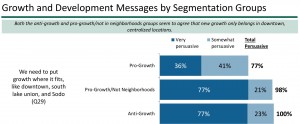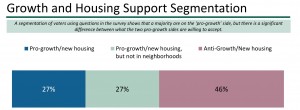More on SCOTUS and MIZ
I mentioned last week that the United States Supreme Court decided not to hear the case against a Mandatory Inclusionary Zoning (MIZ) scheme in San Jose. I pointed out that the decision has no bearing on the proposed MIZ scheme here in Seattle; the San Jose law is for for-sale housing only and the legal issues with Seattle’s MIZ proposal are unaffected by the San Jose case. An interesting blog post from Legal Planet suggests why the case may not have made the cut and they weren’t substantive but procedural.
The reasons behind the justices’ interest in the case are suggested in an opinion by Justice Clarence Thomas concurring in the Court’s denial of certiorari in San Jose. He wrote that “[t]his case implicates an important and unsettled issue under the Takings Clause”–specifically, whether the “unconstitutional conditions” doctrine articulated by the Supreme Court in Nollan v. California Coastal Commission and Dolan v. City of Tigard applies just to “quasi-adjudicatory” decisions of government officials like individual land use permit approvals (the specific factual context in both Nollan and Dolan) or also to “quasi-legislative” government decisions such as San Jose’s enactment of its citywide inclusionary housing measure. As Justice Thomas’ concurring opinion notes, lower courts have split on that particular issue, with California state courts limiting application of Nollan/Dolan principles to quasi-adjudicatory administrative decisions. Justice Thomas left no doubt as to where he stands on that question. (“I continue to doubt that `the existence of a taking should turn on the type of governmental entity responsible for the taking.’”) But Thomas agreed that the building industry’s cert petition may have contained some threshold procedural defects that would have prevented the justices from ultimately reaching the substantive regulatory takings question, and so he joined in denying review in the case.
If you’ve been following the years old story of incentive zoning and linkage and now MIZ, you’ll recognize the Nollan and Dolan cases as being very familiar. It is those cases that form much of the legal discussion on how courts would rule on Seattle’s efforts to squeeze cash out of market rate development for housing subsidies or to mandate that developers build rent restricted housing in their projects. Another interesting and speculative point in the article was what difference it might have made if Justice Scalia hadn’t died before the final decision to deny a hearing.
One wonders whether the Supreme Court might have acted differently on the petition for cert if Justice Scalia were still on the Court. As the original architect of the Nollan/Dolan regulatory takings jurisprudence (he wrote the majority opinion in the landmark 1987 Nollan v. California Coastal Commission case), Scalia was vitally interested in protecting private property rights and shaping constitutional doctrine to that end. Scalia was still on the Court and participated in the first two conferences at which the San Jose petition for cert was debated by the justices. Unfortunately for property rights advocates, he died before the third and final conference, at which the justices ultimately voted to deny the CBIA’s petition. It doesn’t strain credulity to believe that, had he survived, Scalia’s advocacy and crucial fourth vote might have made all the difference in getting the San Jose case before the justices on the merits.
In any event, in California and here in Seattle the legal questions about how these programs pass or don’t pass legal tests will continue. I can’t help but think we’d be much better off building more housing than making new law about how to successfully make bad housing policy, policies that add costs and exactions to market rate development, boosting it’s price, then using the money to pay for subsidies. There are better ways to do this — and they are legal and much more fair and they don’t substantially raise housing prices: the Multifamily Tax Exemption program and the Housing Levy.
MIZ: Harder Than It Has To Be
You remember that Facebook relationship status, “It’s Complicated?” That’s the status supporters and opponents of Mandatory Inclusionary Zoning (MIZ) would have to select when it comes to how they’d explain their relationship to requirements to include rent restricted housing in exchange for modest upzones. Explaining why MIZ works or doesn’t work isn’t easy. It’s complicated! We think it’s very likely infeasible in Seattle. I’d like to point to an article that is glowing about MIZ and argues why, like the subtitle of Dr. Strangelove, that we should learn to stop worrying and love MIZ. But it has a glowing weakness in its argument too.
The article, “The Impact of Inclusionary Zoning on Development,” points out lots of great reasons why MIZ works and places it has worked or been working, producing new affordable housing along with market rate housing. The study argues that there is no adverse impact from MIZ on new development and, in fact, most developers end up loving it — or at least shrugging and working with it. I’m not going to argue with the data presented in he article. Instead, let’s take it as a winning argument for MIZ.
But here’s the flaw and the danger lurking in the supportive case for why MIZ “works:”
Hot Markets and Desirable Development Locales Offset the Cost of Development
In some cities, only minimal cost offsets are provided, and sometimes, none at all. Nevertheless, the best available evidence indicates that development has not slowed in these communities such as Boston,ChapelHill,NorthCarolina,SanDiego,andSanFrancisco.
It’s right there: Boston, Chapel Hill, San Diego, and San Francisco.
Of the four cities mentioned, three, Boston, San Diego, and San Francisco, always make lists of the highest priced rental markets in the country. Seattle is also always on those lists. Always. One top 20 list has San Francisco at #1 ($3,500 per month for a one bedroom!), Boston at #3, and San Diego at #11. Seattle is just ahead of San Diego at #10, and San Jose, which has a MIZ scheme that just survived legal challenge is at #4. New York, considering a MIZ scheme now much like Seattle’s Grand Bargain, is at #2.
Why does MIZ work and why do people love it? As I’ve pointed out before, there is no revenue in a new housing project outside of rent. That is, rents pay for that new building you see. Yep, the cranes, the workers, the trucks, the big excavators, all of it. The monthly rent checks payed by John and Jane Six Pack cover the costs and create the return for investors. The higher the rents, the easier it is to pay to offset the additional construction costs and lost rents created by MIZ. But wasn’t the point to create affordability, not raise rents?
So of course MIZ works when rents are high and, as the Seattle Times repeats in Pavlovian fashion, “skyrocketing.” Add additional construction costs, suppress rent revenues on a percentage of new units created and, voila! Magic! The MIZ scheme works! Of course, those costs and those lost rents are made up for by surging demand for scarce housing which means whatever units aren’t subsidized pay for the ones that are. No problem! Average rents keep going up, paying for local politicians pork barrel entitlement program, and developers make enough money to pay back investors who loaned them the money to build. A win, win, win thanks to a “hot” market.
Hardly. Fueling subsidized housing with a program that raises average housing prices is exactly like a food bank stocked with produce and goods paid for by a policy that adds costs to food that make eating more expensive for people who end up at the food bank. Sure, it “works,” by making the problem worse, then taxing the problem to offset the problem.
Let’s face it, MIZ is folly. The best way to help people with less money to spend on housing is to make more of it — lots more of it, of all kinds, in every corner of the city including housing subsidized by fairly distributed taxes or tax exemptions like the housing levy or the Multifamily Tax Exemption (MFTE) respectively. Creating more scarcity with a policy that raises average prices with additional costs, then taxing that to offset the impact of the scarcity doesn’t make sense. And maybe, like that relationship, it’s smart, sexy and complicated, which is great for politics and romance but terrible for housing policy.
Midrise and Highrise: Movin’ on up!
This originally posted at my old site Seattle’s Land Use Code about 5 years ago. I was talking with someone about our emotional and culturally contextual views of big buildings and thought about this post. I still think this is true: our relationship with buildings is emotional and cultural as well as economic.
I had intended to lead each shift in designation (single family to multi-family, for example) with a sort of general essay about the designation. To be honest I wanted to get the low-rise thing done. It was nagging at me and I found that I couldn’t quite think of anything to write in broad terms about townhouses or triplexes. Those housing types seem to be in some kind of cultural twilight. I can’t even say I knew anyone who lived in a townhouse when I was growing up.
So I skipped it. But not so for midrise and highrise. There is something culturally powerful about living in tall buildings. I guess that statement doesn’t mean much. Let me try to be more clear. Tall buildings generate a complex set of emotions in most Americans. For some, the apartment building represents poverty. For others, the tall apartment building is bad design, and ant hill that is out of scale with human needs. For for still others, the tall apartment building represents a step up.
Let’s look at two slices of popular culture from two different eras. This clip is from I Love Lucy and originally aired a week or so after Dwight Eisenhower was sworn into his second term in the White House.
Where’s the highrise? Well, there were never any exterior shots (that I remember) of Lucy and Ricky’s building, but it’s clear that it is multifamily and that it’s in Manhattan. The show took it for granted that people would understand a family living in an apartment building in Manhattan–a middle class family. This isn’t Mr. Drummond’s place on Different Strokes.
1950’s momentum, though, was not with cities. It was with, as it’s called in this episode, “the Country.” The Country has a very specific meaning in England, but there is a similar sense here. The Country is the place to get away from the dirty city, spread out, grow something. The Country is where people can really live. The country manor is a staple of 19th century literature the way the suburb became the locus of action in the sit-com in the late 20th century. Leave it to Beaver, The Brady Bunch, and on and on.
In this clip you can see the cultural norms about the city changing and the birth of the suburb. One can easily imagine producers of the show getting lots of cards and letters wondering, first, when will Lucy and Ricky have a baby and second, when will they be moving out of the city.
The next clip is a counter example, and the one I’d like to offer for the other possibility. The Jefferson’s was a show I grew up with. Every Sunday night it was certain to be on the tube. As a kid I always thought it was funny, and I took it for granted that moving to the East Side was a good thing. I lived in a single family house in a sprawling Southwestern city and to me New York was a magical world. It made sense that success meant movin’ on up.
Well we’re movin’ on up
To the East Side
To a deluxe apartment in the sky
Well we’re movin’ on up
To the East Side
We’ve finally got a piece of the pie
The “pie” that George and Louise are eating in their deluxe apartment is presumably “American Pie.”
The two clips are remarkably similar. Sad women friends saying goodbye as they consider or make a big move. Even George Jefferson and Ricky Ricardo have some things in common. What is notable is the direction of the move — not what it means.
For Lucy and Ricky moving to the country is certainly a step up and away from the dirty city. Lucy plays up the cultural stereotypes of city life in her efforts to persuade Desi. But she doesn’t have to, Ricky has already made the $500 deposit, about $4,000 in todays dollars. It is a significant sum to lay down as a deposit for a hard working band leader.
The Jefferson’s are also moving toward their dream. But rather than moving away from the dirty city, Manhattan, they are moving towards it. Lucy and Desi wind up in Connecticut and Ricky commutes (by train!) to work in the City. But George and Louise move to a highrise apartment. The motives are the same: economic and cultural mobility. The feelings are the same: where we are now isn’t good enough, we deserve better. The sense of importance about the meaning of “home” is the same.
But the outcome is decidedly different. Ricky commutes but George lives above the store. These are social constructs separated by decades, issues of race, demographics, and evolving sexual and cultural norms. But we can influence these. I look forward to a day when our cultural expectations shift enough (and they will) that we’ll measure social mobility by what floor a family lives on than by the size of their single family house.
US Supreme Court Won’t Hear San Jose MIZ Case
In a blow to California housing builders the United States Supreme Court chose not to hear an appeal of a San Jose, California requirement for Mandatory Inclusionary Zoning (MIZ) requiring for-sale housing have set asides priced lower than the market. From a story in the San Jose Business Journal:
San Jose’s mandate that homebuilders either include affordable units in their projects or pay a fee will stand, after the U.S. Supreme Court on Monday declined to hear a challenge to the law. In a victory for affordable housing advocates and the city of San Jose, the court said it would not hear the appeal of a California Supreme Court ruling last year brought by the Building Industry Association.
This has zero effect on our own Mayor’s proposal for MIZ as part of the Grand Bargain. But an outright rejection of the San Jose law might have helped lend some clarity to legal arguments against the proposal which would add a roughly 10 percent increase to building size all over the city with a 7 percent set aside for rent restricted housing. To be clear, California had been the guide for MIZ schemes all over the country. But the failure of the San Jose case to get a hearing in front of the Supreme Court doesn’t make it any more legal here. In fact, the idea itself of MIZ is perfectly fine in Washington State law provided that there is a value added to projects with an upzone and that participation is voluntary (let’s call it VIZ). So far, there’s nothing in the Bargain that indicates either of these requirements. So knowing your way to San Jose might help clear up some questions about MIZ, but it will be Washington courts that will have to weigh in if the Mayor pushes ahead with his road trip.
Will Grand Bargain Jeopardize Murray’s Reelection?
In the first half of last year we conducted a poll of perfect voters ahead of the election in the fall. We wanted to get a sense of what voters were thinking about population growth and the change and new housing associated with more people coming to Seattle for jobs and to start new businesses. We found voters mostly stuck in the worrisome narrative we’d guessed: growth is good but it’s happening too fast and should be slowed down with fees. Highlights were that voters believe short supply drives up prices which is true, and a lowlight was their belief that builders are large, outside corporations which is not. I paid the poll results a visit to consider what they mean for the upzones associated with the Grand Bargain.
There are two key points we landed on with the poll results. First, most voters get that growth is good, and are for increasing growth. About 68 percent of respondents agreed with the statement, “Seattle’s growth is a positive thing, it is making Seattle more diverse and vibrant.”
And a “majority of voters (57 percent) are in the ‘pro growth” category.” However, about half of those voters (27 percent) “are generally against new housing and growth in single-family neighborhoods.” Over all, “46 percent are generally against more growth and more new housing.”
On its face, the alloyed nature of support for growth and and the need for housing it creates, doesn’t bode well for lots of big upzones in the neighborhoods. This is especially true for efforts to add any density to single-family neighborhoods; significant majorities oppose any changes there.
This is why the Mayor so rapidly changed course on suggestions made by his Housing Affordability and Livability Agenda (HALA) Committee to add more housing choices and types to single-family neighborhoods. Looking at the numbers from last year makes the politics drop dead obvious: leave single-family neighborhoods alone.
But where, according to voters, would growth be best suited?

Interestingly, even the anti-growth segment is against more growth, to the extent it happens, they want it downtown. So those most skeptical of growth and those who favor it outside single-family want it Downtown and in South Lake Union.
Another interesting element of things that make voters more supportive of growth is building more affordable housing.

So one way to look at all this is something like the following:
Voters throughout the city generally support growth, but would rather see more of it in places like Downtown and South Lake Union rather than in their neighborhoods and in single-family zones. One thing that would make that growth more acceptable is the development of affordable housing.
What should worry the Mayor, if he’s considering reelection, is proposing major upzones in neighborhoods while not building any affordable housing Downtown and South Lake Union. That’s this one place EVERYONE agrees growth should happen; yet the Grand Bargain does exactly the opposite, proposing upzones Downtown and South Lake Union with no affordability requirement. Because the Bargain keeps fees low in those neighborhoods, builders will pay in lieu fees, not build.
The upzones for Downtown and South Lake Union will be a done deal by 2017, the Mayor will be offering just the upzones with affordability everywhere else to voters who are generally skeptical of growth and housing in the neighborhoods. It’s true there are ways to persuade, but it’s going to take quite a bit of effort to persuade neighborhoods that growth should happen in their back yard when they’ve been pretty clear they want it downtown.
Remember, also, that the City Council’s district structure means angry neighbors are also angry constituents, and the temptation to run against the “Mayor’s Bargain” or the “Mayor’s Upzones” will be irresistible for Councilmembers running for reelection — and, maybe, for someone who might challenge him directly. The campaign could be all about who listens to your concerns? Certainly not the Mayor, right? He made a deal with big downtown developers and now you’re having to take growth and housing you’d rather have go somewhere else.
Our position is clear: build more housing, of all types, in all areas of the city (Including single-family areas), for all levels of income and without infeasible and illegal mandates. More housing is the answer and that does mean adding more capacity–including upzones. That isn’t a politically popular idea however. But we’re not running for reelection in 2017.
Methodology
-Telephone survey of likely November 2015 voters in City of Seattle
-Conducted April 6 – 9, 2015
-475 total interviews citywide; ±4.4 percentage points
-Weighted to reflect City of Seattle likely November 2015 voter population using key demographics
-Interviewing conducted by trained, professional interviewers





